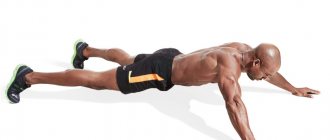You can also visit the gym, which is equipped with sports equipment and exercise machines. At the same time, these are very difficult exercises; they cannot be performed by a person whose muscle strength is not sufficiently developed. Experienced athletes use weighted pull-ups to achieve rapid muscle growth. In this article we will look at the correct execution of exercises on the horizontal bar with weights and how to choose the right weight for the weight.
- What muscles work
- Benefits and contraindications
- When to add weights
- How to choose the right weight
- How to do it right
- Examples of training programs Workout - training program from turnstile man Hannibal
When and who needs pull-ups with extra weight?
The use of weights in pull-ups is necessary, first of all, for those athletes who have reached a certain level of physical fitness. Also, pull-ups with weights are relevant for athletes of those sports in which the back muscles, their endurance and strength play an important role. Such athletes are considered to be powerlifters, players of some positions in American football, bodybuilders, wrestlers and many others. And, of course, amateur athletes who create a figure with a wide triangular torso.
Benefits and disadvantages of weighted pull-ups
Benefit:
- Weighted pull-ups are the most effective exercise for increasing the strength, mass and size of the back muscles.
- The exercise allows you to work with any weight - from minimal to extreme.
- Increases the width of the back.
- Creates a powerful muscle corset.
Flaws:
- The downside of weighted pull-ups can be considered contraindications regarding health, because they create a strong stretch of the intervertebral discs and muscles.
- The exercise is only available to well-trained athletes who have a strong muscle corset and no spinal injuries or even old injuries that may remind themselves after such a load.
Force
It must be admitted that pull-ups can be classified as strength exercises, especially for those who cannot do a single pull-up or only do 2-3 or even 6 pull-ups.
The essence of developing strength is the essence of growing myofibrils, which create the main muscle volume of the muscles. Therefore, it is not surprising that initially, increasing the number of pull-ups gives obvious muscle growth.
For some beginners, deliberate work on increasing their pull-ups resulted in biceps growth of 3 cm in the first 3 months of training.
Muscle strength is the basis of pull-ups, on which you need to layer endurance.
How to attach a weight to a belt
There are many options for using weights. The simplest and most convenient is to use a special belt with a chain on which you can hang any of the possible sports equipment, be it weighted discs, dumbbells or weights. This belt has a carabiner for easy fastening.
But not everyone has such sports equipment as a belt with a chain and it can only be found in gyms, so it should be replaced in home workouts. This can be done using an elastic band for pull-ups, which should be secured on one side to a sports equipment, such as a dumbbell, and the other side should be held with bent legs. A backpack with a load can also serve as an alternative.
After a long break
After a forced break in training, we recommend doing 2 sets instead of 3 or 4. And taking the weights 50% of those you used when you were still training. Yes, after training your muscles will ache. Strongly. But not so much that you fall behind schedule for a week.
In the future, you will gradually return to your working weights and begin to progress. Start small and increase the weight in each approach: for a barbell - by 10 kg, for dumbbells - by 2. You definitely won’t miss!
Bench press example
Warm up: empty bar, 20 reps. We weigh 10 kg and do a set. We hang another 10 and work. And there we reach 60 kg. If it becomes difficult in some approach, then there is no need to increase the weight in this workout. In the future, when it becomes difficult, add 1-2 kg and look at the result.
Wide-grip pull-up technique with weights
As in other types of pull-ups, the starting position will be hanging on the crossbar; only when working with weights under the horizontal bar, it is best to place a stand (bench) for a convenient and easy, and most importantly, safe approach to the crossbar.
- It is necessary to place your hands on the bar as wide as possible. The wider the grip, the more the back muscles are involved, and the load on the arms is reduced. This is due to the short amplitude.
- As you exhale, bending your back in the thoracic region, pull yourself up to the bar by contracting your back muscles.
- The end point of the movement will be reached when the chin is approximately at the level of the bar.
- At the top point, you should pause for a second and slowly, concentratedly lower yourself to the starting position.
What muscles work
The classic technique of performing pull-ups is not very complicated in appearance: using the hands, holding the bar with the palms, a person lifts the body vertically upward, and then smoothly lowers down to the starting position. However, this exercise is quite difficult, and considerable physical strength is required to complete it.
Muscles directly involved in the exercise:
- biceps;
- muscles of the forearms;
- latissimus dorsi;
- large and small round muscles of the back.
Despite its difficulty, experienced athletes recommend including this exercise in your weekly training plan.
Hard work on the horizontal bar will bring abundant fruit to the owner of the body. Did you know? The 17-year-old from Northern Virginia has done 7,300 pull-ups. During the first six hours, the teenager did pull-ups at a rate of 10 exercises per minute; in total, it took more than 15 hours to complete.
There are many variations of this exercise, all aimed at getting the best end result.
You can do pull-ups:
- so that the chin touches the crossbar;
- touching the bar with your shoulders;
- touching the bar with your stomach;
- with a body turn in the air (around the crossbar);
- with clapping of palms in the air (for pros);
- with legs raised to a right angle position;
- only on the right or only on the left hand;
- with weights on the legs, belt, forearms, and neck;
- with performing lateral pull-ups on one arm;
- doing a “plank” or “scissors” in the air over the bar.
Did you know? The idea of progressive training came to our contemporaries thanks to the ancient Greek legend of the wrestler Milo from the city of Croton, who trained daily while carrying a small calf on his back until the animal was fully grown. Thus, the load on the wrestler's back increased slightly every day, and along with it his strength increased.
Reverse grip pull-up technique with weights
- To perform pull-ups with weights conveniently and safely, you should place a bench.
- Having taken the starting position, as you exhale, you need to pull yourself up to the crossbar using the target muscles.
- The back in the thoracic region should be arched, and the arms should be pressed as close to the torso as possible. Elbows cannot be spread to the sides.
- At the top point of the amplitude, you need to linger, and then slowly lower, taking the starting position.
- On the return movement you need to inhale. The reverse movement is performed slowly without jerking.
The safest exercises for the upper back[edit | edit code]
Man is born to do pull-ups. This is the safest exercise that works with natural biomechanics, not against it. This is very important because the back, if not trained correctly, is easily injured, and a healthy back is the basis of a healthy life. The lower back is often injured, mainly due to improper lifting technique. But no one has ever suffered a back injury from doing pull-ups.
When the legs are in the air, the lower back does not receive any external load - during the exercise the back remains in its natural position, maintaining the inherent curves of the body - the spinal erector muscles work.
Regular pull-ups work the muscle corset and protect your back from injury. Many powerlifters have an unnaturally developed outer deltoid due to all kinds of arm presses. Due to an imbalance in the development of the shoulder girdle, such athletes are susceptible to various injuries. Pull-ups strengthen the posterior deltoid muscle in the shoulder. By gradually adding pull-ups to your workout, you will in a short time get rid of unbalanced development of the shoulders and arms, thereby preventing various types of injuries. The correct technique will strengthen your joints, which other back exercises cannot do.
Recommendations for implementation in training
- This is definitely the first exercise in your back workout. You need to calculate the weight so that you have enough strength for 3-4 sets of 8-12 repetitions.
- The weight in this exercise should be increased in small increments, and even adding five kilograms in pull-ups is felt great, unlike, for example, increasing the weights in leg training.
- In no case should the exercise be performed with a jerk or suddenly lowered, relaxing the muscles. This technique will lead to inevitable injury, such as sprains.
- There is no point in chasing more weight. It is better to slowly, gradually increase the working weight, but perform the exercise correctly and the right number of times, than to jerk three repetitions, but with a lot of weight.
Examples of training programs
Major Armstrong's Pull-Up Program
| School days | Daily task |
| 1 day | Five approaches, in one approach pull-ups are performed at the maximum level, between approaches there are 90 second breaks. |
| Day 2 | "Pyramid". The first two approaches with a maximum “extension”, between them there are 60 seconds of rest, after which in the following approaches an additional 10 second timeout is taken between each pull-up, for example, if 2 exercises are completed, the athlete rests 20 seconds, after three - 30 seconds, after four - 40 seconds. Between the first and second exercises, rest for 10 seconds. |
| Day 3 | 9 approaches (sets) are performed with a fixed number of pull-ups, the maximum for a particular athlete. These 9 sets will consist of three grip variations: 3 sets with a wide grip, 3 with a medium grip, and 3 with a narrow bottom grip. The rest time between each set does not exceed 1 minute. |
| 4 day | The maximum number of fixed pull-ups is done. That is, if the fourth day assumes that the mandatory 9 approaches are performed, then on this day it is necessary to perform the maximum possible number of sets, changing the way of gripping the crossbar every three approaches. Rest time between sets is 1 minute. |
| 5 day | The program of any day that turns out to be the most difficult to complete is repeated. |
class="table-bordered">
Workout - training program from turnstile man Hannibal
| In one workout, you need to complete 11 approaches, which are done with virtually no rest breaks, in a circular system. | Execution order |
| Pushups | In total, 275 push-ups are done during the workout, the athlete does 30 push-ups in the first approach, and one push-up less in each subsequent approach. |
| Pull-ups on the horizontal bar | During the workout, only 70 pull-ups are performed, for the first approach - 10, in each subsequent approach there are one less, in the last six approaches five repetitions are performed. |
| Push-ups on horizontal bars | A total of 165 push-ups are performed, 20 times on the first approach, decreasing by one push-up in all subsequent approaches. |
| Pull-ups with reverse bar grip | The exercise is performed 70 times, in the first approach - 10 times, with each subsequent number of pull-ups is reduced by one, the last six approaches - 5 repetitions. |
class="table-bordered">
Important! Before an athlete begins to perform exercises on the horizontal bar, a warm-up is necessary, during which the muscles will warm up. Warm-up time varies from 5 to 15 minutes; it is a prerequisite for safe sports activities.
If an athlete ignores the warm-up, the workout may end in muscle and ligament rupture.
How to increase your weighted pull-ups
As already mentioned, the increase in working weight should be gradual. There is no need to rush, and it is unlikely that you will be able to progress quickly in this exercise. But it is still possible to speed up progress as much as possible. To do this, you should perform a set of exercises. In order to increase the number of weighted pull-ups, you should use a weight that is a quarter greater than the current one working. Accordingly, the number of repetitions will be less. To develop strength, 6-8 repetitions and 5-6 approaches will be enough. The scheme is unusual, but perfect for achieving progress. Such training can be carried out no more than twice a month.
Exercise Chart for Weighted Pull Up Progression
| Name | Number of repetitions | Number of approaches |
| Pull-ups with a pause when the angle at the elbows is 90 degrees (can be performed with weight). | 6-8 | 5-6 |
| Pull-ups with a weight as wide as possible (to exclude arm muscles). | 6-8 | 5-6 |
| Negative weighted pull-ups. | 6-8 | 5-6 |
| Vertical block pull. | 6-8 | 5-6 |
| T-bar row. | 6-8 | 5-6 |
Read more about negative pull-ups →
World records
Today the following Guinness World Records have been recorded for pull-ups on the horizontal bar and parallel bars:
For speed:
- in 60 seconds: 54 pull-ups from Boris Nalbantov, Sofia, Bulgaria, June 17, 2020;
- in 1 hour: 1,009 times by Stefan Huland in 2010;
- in 6 hours: 3,515 times by Andrew Shapiro in 2020;
- in 12 hours: completed 5,742 times by Andrew Shapiro in 2020;
- in 24 hours by men: 7,600 times by John Orth, June 11, 2016;
- in 24 hours from women: completed 3,737 times by Eva Clarke in 2016.
On one hand:
- first place in one-arm pull-ups in one minute: 30 times from Blake Augustine Dick in 2020;
- in second place: George Gaidardzhiev - 17 pull-ups per minute;
- third place: Maibam Itomba Meity (India) - 16 pull-ups, performed in 2014;
With additional weight (burden) in one minute:
- heaviest weight: 230.49 lb (104.5 kg), achieved by David Marchante in 2020;
- with 40 lb (18.14 kg): 31 reps, performed by Ron Cooper (USA) in Marblehead, Massachusetts, USA on September 7, 2020;
- with 60 lb (27.21 kg): 23 reps, done by Ron Cooper in 2016;
- with 100 lbs (45.36 kg): Stephen Proto did 14 pull-ups on October 15, 2014.
Find out how to increase the number of pull-ups you can do on the bar.
Pull-ups on a horizontal bar are an exercise that initially requires the athlete to be in good physical shape, and performing them with weights is much more difficult than its original version. But it’s not the gods who burn the pots, and everyone, through persistent repetition, can achieve excellent results in this sport, as well as a beautiful figure with well-defined back muscles.
How to choose a weighted pull-up belt
- You can buy a belt made of leather, but the most budget-friendly belt is made of nylon. They are wide with lumbar support and narrow. It is better to give preference to wide format models. Usually (almost all) weight belts come in one size, so be sure to try one on yourself when purchasing.
- When threading the chain through the ring or bracket, make sure that the belt fits snugly to your body and will not fall with the weight on the floor during the exercise, or, worse, on your feet.
- The belt width is adjusted using the chain itself. These belts have a weight limit. The limit of a nylon belt is most often 100 kg. In principle, this will be enough “headlong”. Leather belts are considered professional. They are more expensive, but also have their advantages, for example, developed lumbar support and a larger diameter chain.
It is difficult to say which belt is better - leather or nylon and can be determined experimentally. By the way, leather belts can withstand weight up to 150 kilograms!
Today there are several brands that are worth paying attention to. Among them:
- WORKOUT.
- YOUSTEEL.
- ONHILLSPORT.









